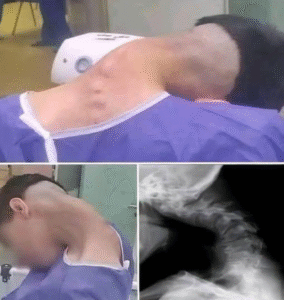Dropped Head Syndrome in Young Adults: The Hidden Consequences of Poor Posture
In an age dominated by screens and digital devices, the phrase “tech neck” has become all too familiar. Many young adults experience neck stiffness, shoulder pain, and a forward-leaning head posture after long hours hunched over phones or laptops. But while these symptoms are often brushed off as minor or temporary, doctors are now warning of something more serious: Dropped Head Syndrome (DHS) — a condition that, though rare, is increasingly appearing in younger generations due to poor posture and lifestyle habits.
This isn’t just about a sore neck. Dropped Head Syndrome can have profound physical, emotional, and even neurological consequences. Understanding its causes, signs, and preventive measures could help a generation of young adults avoid a future of chronic pain and mobility challenges.
What Is Dropped Head Syndrome?
Dropped Head Syndrome (DHS) is a medical condition characterized by extreme weakness of the neck extensor muscles — the muscles that hold your head upright. As these muscles weaken or become damaged, the head progressively tilts forward and downward, creating a characteristic “chin-on-chest” posture.
In older adults, DHS is often associated with neuromuscular diseases such as Parkinson’s, myasthenia gravis, or amyotrophic lateral sclerosis (ALS). However, in recent years, specialists have noticed a worrying trend: more young and otherwise healthy individuals are exhibiting early signs of the same problem — not because of a neurological disorder, but due to chronic poor posture.
The Posture Epidemic
The average adult spends over eight hours a day looking at screens. Smartphones, tablets, laptops, and gaming consoles have all contributed to a widespread habit known as forward head posture (FHP) — a position where the head juts forward relative to the shoulders.
While the human head weighs about 10–12 pounds in its neutral position, every inch it moves forward effectively doubles the load on the neck and upper spine. For instance, leaning just three inches forward can put more than 40 pounds of pressure on the cervical spine. Over time, this excessive strain leads to muscle fatigue, tightness, and eventually, degeneration.
For many young adults, this sustained stress can set off a chain reaction: weak neck muscles, compressed nerves, and altered spinal alignment — all of which may pave the way for conditions like Dropped Head Syndrome.
How It Develops: From Slouch to Syndrome
The progression from poor posture to DHS doesn’t happen overnight. It’s gradual — and that’s what makes it so dangerous. The early warning signs can be subtle:
-
A dull ache in the neck or upper back after long periods of sitting.
-
Frequent headaches that start at the base of the skull.
-
A noticeable rounding of the shoulders.
-
Fatigue or tension when trying to maintain an upright posture.
As muscle imbalances grow, the extensor muscles (responsible for keeping the head up) weaken, while the flexor muscles (used to look down) become tight and overactive. The imbalance deepens until the neck muscles can no longer support the weight of the head — and gravity takes over.
In severe cases, individuals may struggle to lift their heads at all without using their hands, a hallmark sign of advanced Dropped Head Syndrome.
Physical and Emotional Consequences
Beyond the visible changes in posture, DHS can have far-reaching consequences on physical health and emotional well-being.
1. Chronic Pain and Spinal Issues
When the head consistently tilts forward, it compresses the cervical vertebrae and surrounding nerves. This can lead to chronic neck pain, disc herniation, and even early-onset arthritis. The altered alignment may also cause compensatory changes in the lower spine, leading to back pain and reduced mobility.
2. Breathing and Digestion Problems
A forward head position restricts the movement of the rib cage and diaphragm, limiting lung expansion. Over time, this can reduce oxygen intake and endurance. Additionally, slouching compresses the abdominal organs, potentially slowing digestion and contributing to issues like bloating and acid reflux.
3. Impact on Mental Health
Posture and mood are deeply interconnected. Research has shown that slumped postures can increase feelings of stress, fatigue, and even depression. For young adults, living with chronic pain or visible posture deformity can also affect self-esteem, body image, and confidence.
Why Young Adults Are at Risk
The rise of DHS among younger populations can largely be traced to modern habits and lifestyles:
-
Tech dependence: Hours spent texting, scrolling, or working on digital devices.
-
Sedentary routines: Lack of movement weakens postural muscles.
-
Poor ergonomics: Chairs, desks, and screens that encourage slouching.
-
Lack of awareness: Many underestimate how much strain poor posture places on the neck and spine.
The problem is especially concerning because the bones and muscles of young adults are still adapting. What begins as mild discomfort at 25 could become a permanent structural issue by 40.
Diagnosis and Treatment
Diagnosing Dropped Head Syndrome involves physical examination, imaging (like MRI or X-rays), and sometimes nerve or muscle studies to rule out neurological causes. For posture-related DHS, treatment focuses on rehabilitation and realignment rather than medication.
1. Physical Therapy:
Targeted exercises can strengthen neck extensors and stretch tight flexors. Therapists often focus on retraining the body to maintain neutral alignment, improving mobility and endurance.
2. Postural Correction:
Ergonomic adjustments — such as raising screens to eye level, sitting upright, and taking frequent breaks — can dramatically reduce strain.
3. Supportive Devices:
In severe cases, neck braces or posture supports may be used temporarily to alleviate pressure and allow muscles to recover.
4. Lifestyle Changes:
Incorporating yoga, pilates, or strength training can improve overall posture and prevent relapse. Reducing screen time and maintaining an active lifestyle are essential for long-term recovery.
Prevention: The Power of Awareness
Preventing Dropped Head Syndrome begins with small daily habits:
-
Keep screens at eye level to minimize forward tilt.
-
Sit with your back straight, shoulders relaxed, and feet flat on the floor.
-
Take a short break every 30 minutes to stretch or move.
-
Perform neck-strengthening exercises regularly.
-
Avoid looking down at your phone for extended periods — lift it instead.
By being conscious of posture and body mechanics, young adults can protect themselves from a future of pain and disability.
Looking Ahead: Rethinking Modern Health
Dropped Head Syndrome may sound like a rare or distant concern, but it’s a stark reminder of how modern lifestyles are reshaping our bodies. The convenience of technology has come with an invisible cost — one that affects not only our muscles but our very relationship with movement, awareness, and health.
For young adults, the message is clear: posture matters. The way you sit, stand, and move today will shape the way you live tomorrow. Dropped Head Syndrome is preventable, but only if we take the signs seriously before it’s too late.
In a world where we often look down — at our screens, our tasks, our worries — perhaps it’s time to look up again. Literally and figuratively. Because standing tall isn’t just good for the body; it’s a declaration of strength, confidence, and self-respect.


